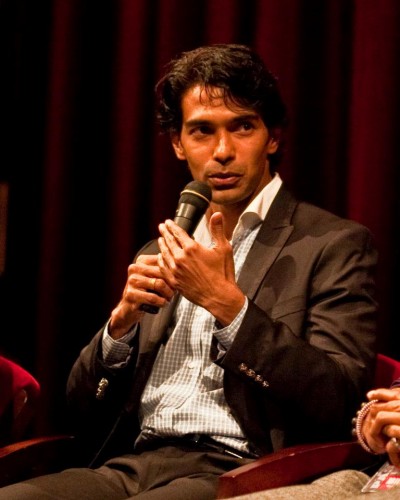As an independent filmmaker, you need to be a little bit of an entrepreneur too: Sandeep Mohan
With the sole purpose of telling an interesting story in a manner that excites him, has made filmmaker Sandeep Mohan give the audience two feature films that were full of wit and quirk. His debut film Love, Wrinkle-free released theatrically through PVR Director’s Rare in 2012. Following a different approach to reach the audience for his second film Hola Venky, he then traveled to around 90 alternative spaces around the world with an innovative concept called The Great Indian Traveling Cinema. Sandeep who was also one of the 11 filmmakers of the collaborative feature film X – Past is Present speaks to Pandolin about his third film Shreelancer, which releases in theatres today.
Here are excerpts from the interview that was taken when the filmmaker began shooting Shreelancer.

Sandeep Mohan
How would you describe the storyline of Shreelancer.
With each film, you try to do something different. You can call ‘Shreelancer’ a travel film, maybe. Since we are in the process of shooting right now, I doubt if I’ll be able to share the storyline right now. Why spoil the fun for the audience right away?
What was the casting process for the film like?
I have cast some really interesting people – some are professional actors while some, I have chosen from real life because they are interesting people. The professional actors are also mostly from the theatre world. The guy playing Shreelancer is Arjun Radhakrishnan who has done a lot of theatre and some independent films. Then there are a couple of French actors to. US-based Giju John, the producer of the film, is also playing a cameo in it.
Who is the Cinematographer of the film?
Shreelancer is shot by Subhash Maskara. This is his first independent film though he has shot some short films in which I have really liked his work. It is nice to work with new people.
For Hola Venky, you tried to keep the budget to a bare minimum by shooting it with a three-member crew. Have you followed something similar for Shreelancer as well?
I’m actually following the same philosophy. In Hola Venky, the crew comprised three members, but here (in Shreelancer) we are 15 people since it is a travel film and there are a few more logistics to be taken care of. But the approach is the same. It is shot very tightly with a low budget. This is my way of shooting a film. No wastage, no excesses.
In fact, you wrote Hola Venky keeping its budget in mind. Was Shreelancer also written with the same theory?
Yes, I always have the budget in mind. I write the script accordingly. I did a recce for a month just to see whether the script (of Shreelancer) can be shot at those locations in that particular budget. I can’t afford to be extravagant. We stay in small hotels, share rooms and not let the story suffer. I travel in buses and trains to keep my expenses minimal. When I was traveling to showcase Hola Venky at different places, I used to sleep anywhere where there was a sofa, wash in the café washroom and even avoided staying in hotel rooms to cut costs. Despite all this, my films look richer than the average low budget films, I believe. Because whatever money I have, goes into making the film rich, not to feed my ego or my flight and food expenses!
Your passion makes you work even on a shoestring budget. But when there are 15 minds working together, do they work accordingly?
I pretty much pick and choose my crew and they know my philosophy towards life. I’m quite upfront about how I work and how things are going to be. It is better, to be honest about it. It is important for them to follow the same approach, otherwise, they can’t be part of the team. Since the cast and crew are aware of this in advance, we all work together as a team without any issues. It also helps that we are mostly like-minded folks working together.

Actor Arjun Radhakrishnan during the making of Shreelancer
In such a case, does a writer or a director manage to do justice to what he actually wants to say or make?
You can always do good stuff with what you have. If you have very less money, you can still make tasty food. Expensive food doesn’t really have to be tasty. It is all about how you see it. One might end up making a bad film with 50 crore but you can still make a good film with 5 crore or 5 lakh. If you put your heart and soul in it, you can make a decent film.
After making two films and getting interesting reviews for it, have things been easier with Shreelancer?
At the end of the day, Shreelancer is a new project for me. So it’s an altogether new challenge. And I think nobody knows filmmaking. Even after doing two or ten films, you are still figuring out many things. So it is not easy. Shreelancer is much more difficult than the last two because it involves traveling on a tight budget. Normally, people shoot tight budget films in a single room or with very few actors. In our case, it is the other way – we have a lot of actors and the film is being shot at different locations. But this is something that I enjoy. I like the adrenaline rush that comes with this approach!
You often shoot guerilla style. Was the same adopted for this film as well?
It is mostly going to be shot in guerilla style. We are also taking favours from friends who can help us with locations. Like I said, I did an extensive recce for the film. So, instead of hiring line producers for the production process, I preferred doing things on my own so that our expenses remain within the budget. I have a hands-on approach to most of the departments of the film.
Will Shreelancer do any festival round?
For Hola Venky, I didn’t go to any festivals. And I don’t write typical so-called festival films (though I enjoy watching them). I believe my films are engaging. Also, it is important to know who your audience is and how to reach them. So if they can’t catch my film at the nearest cinema hall, I might take it to their space – like I traveled with my last film Hola Venky for 15 months.
I distributed it through ‘The Great Indian Travelling Cinema’ in which I traveled with the movie to various alternate spaces such as corporate offices, homes of people, libraries, bars, cafes, restaurants, art galleries, church halls, town halls etc. I traveled with my own projector and screened the film in many cities in India, USA and Singapore. People paid on a donation basis. I would also take questions before and after the movie screening.
With Shreelancer, I am hoping that that it gets a proper theatrical release. But I might still travel and take the movie to more spaces. In addition to this, there are a lot of online options these days. Being my third film, I am getting a bit more experienced about the workings of the industry, by which I mean I am clueless as ever! (laughs)
With two films under your belt, do you still have to do ads, direct corporate films or write for others? Do you do these jobs just to raise money for your own films or is there a deeper interest towards them?
At the age of 21, I started assisting Sanjay Leela Bhansali on his film Hum Dil De Chuke Sanam. After that adventure, I left Mumbai and went to Bangalore, got into advertising as a copywriter. After a few years, I came back to Mumbai and became a writer in TV and started working on my indie experiments. I don’t write for others anymore. I didn’t enjoy the TV writing process. Now I try to focus on ads and corporate films. But I don’t really get paid big amounts, which I can use to produce my films. But yes, it helps in sustaining myself and covers my travels to the cafes and the green teas and the occasional beers. (Smiles)
What is your take on the marketing and the distribution scene for Indie films in India? After having made two films, do you think making a film is easier than taking it to cinema halls?
Different people have different ways of seeing it. I would say that it is very important in today’s world. As an independent filmmaker, you got to be a little bit of an entrepreneur too. The way the industry functions, an indie filmmaker is left with no choice. No point fighting with the biggies, instead focus on staying innovative and taking the film to a wider audience.
With Hola Venky, I decided to take the initiative and travel with the movie and create an alternative method of screening a movie. Lots of innovations are happening in the online space too. The movie viewing habits of people are changing drastically. And things are going to change a lot more. But what won’t change is the human need to hear stories. We all need it. I hope to be able to tell stories forever.
Is innovation directly proportional to the dearth of the suitable platform for indie films? For instance had your debut film Love, Wrinkle Free got a better release you might not have come up with the brilliant idea of The Great Indian Travelling Cinema for Hola Venky.
I totally agree. In fact, you create better when there are limitations. When you are given distribution on a platter, things are easy for you. For an independent film, your job is not finished when you create a film. Once the film is made, you have to take the same amount of effort to take it to the audience. Also for me, a movie only becomes a movie when there is an audiences for it. I try to stay innovative and keep my eyes and ears open for new ways of reaching my audience.
How fascinating has the process of filmmaking been?
I’m not from a filmi background and have pretty much been raised in a normal middle-class home. I always liked telling stories and writing. The most interesting part of the filmmaking process for me is the scripting part. Also, in the process of making a film, you get to learn so much about yourself. As for me, when I am writing, I am not thinking whether this will make 100 crore or not. In fact, I would be more than happy if producers get their money back and make some out of it. That’s why I always try to keep a tight budget.
I explore themes (in my stories), which I’m having certain self-doubts about. Then for almost a year and a half, I live with this theme, exploring it, debating upon it in my mind. This keeps me motivated, it gives me energy. Also, filmmaking is like therapy for me. In fact, one of the greatest learnings from each of these films that I have made is that things are not totally in our control.



